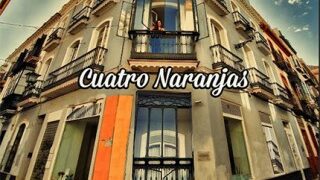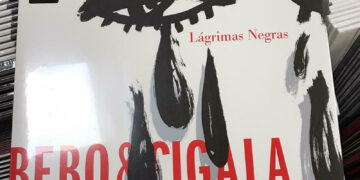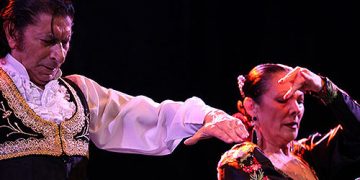|
18th FESTIVAL FLAMENCO CAJAMADRID 2010 Teatro Circo Price
TONI EL PELAO Y LA UCHI: La dinastía centenaria del baile flamenco. DIEGO EL CIGALA THE EFFICIENT ADMINISTRATION OF ART Text: Manuel Moraga
A night of Madrid gypsy culture for the third show of the Festival Flamenco Cajamadrid which made room for a singer raised in the Rastro neighborhood, and a century-old dance dynasty that has always been proud of its Madrid roots: the Pelaos. The current artistic patriarch of the family, Toni el Pelao, had an emotional reencounter with the stage after having spent several months in a critical state of health. Cigala, for his part, transported us from the heart of Madrid to the most Latino part of New York. Make no mistake ladies and gentleman, Madrid has produced, and will still continue to produce a lot of flamenco artists. Not that we subscribe to that chauvinistic native who said “…but is it really possible to be from some place other than Madrid?”, but nor do we want to forget the importance of Spain’s capital in the imaginary borderless flamenco territory of the mind. Schools such as Amor de Dios, venues como Casa Patas and Las Tablas, performers like Serranito, La Tati, El Güito, el Yunque, Jerónimo Maya, José Maya, Pedro Sanz, Alfonso Losa, el Entri, Jesús de Rosario and a long list of other artists born in “The Foro”, not to mention the endless number of those not born in Madrid, but who have passed through the city to study or work. And this is not exactly a Madrid-promoter talking to you, because I’m not. I’m not even from Madrid, but that doesn’t change the reality. Getting down to business now, I want to begin by saying that mere hours ago I interviewed Belén Maya for the program “El Callejón del Cante” (Radio Exterior de España) in which the dancer explained that her current line of work does not stop at an obsession with technique, but strives to find out how to extract maximum output from all conditions and circumstances. That is what I call effective administration of talent, and therefore of art. And a few weeks back, on the same program, Manuel Liñán explained the difficulty he felt in drawing the supposed line that separates traditional from modern, precisely because “tradition is advancing all the time” commented the Granada dancer. Both perspectives bring me directly to what Toni El Pelao and La Uchi represent.
In today’s rat-race of consumerism people want everything that seems youthful, and all too often we forget there are immutable values in all things; including the world of dance. We tend to confuse that which is young with that which is new, and it’s not the same thing, just as it is not the same to be cultured as to be wise. If humankind did not react in this way, many generations would have been deprived of Euripides, Shakespeare or Unamuno based on the single argument that Stieg Larsson or Ruiz Zafón are more recent authors and their literary technique is more in line with contemporary expectations. We are, therefore, speaking about classics, which is exactly what the dancing of Toni El Pelao and La Uchi represent. You can challenge them on what we call technique, but their aesthetic credentials are unquestionable and we need to cast a glance in their direction occasionally to reach new conclusions. Last summer Antonio Manzano Bermúdez, Toni el Pelao, miraculously survived a broken aorta he suffered unexpectedly in the middle of a Madrid street. But his fortitude and background got him through it, and now, happily recuperated from the mishap, he has returned to the stage to show, among other things, that his style transcends modern trends and is here to stay. Caña, farruca in the style of his family, alegrías and romeras, plus the malagueña of José Anillo and the soleá of Pepe Jiménez, because Toni El Pelao knows how to yield center-stage to his people. This new lease on life of Pelao’s tinged the entire show. The placement, the arms, the poses, the verticality, the absolute concentration on conflict without superficiality make this masterful couple’s dance a permanent and intense communication with the audience. And they don’t need to race around the stage a mile a minute: the really important thing is the specific gravity and knowing that what is taking place is a true communion that feeds on that most sensitive of materials we call “art”. La Uchi and El Pelao are faithful followers and practitioners of that religion. And furthermore, their dancing, especially that of Toni, is pure Madrid. El Pelao has the characteristic swagger, in the best sense of the word, that Madrid natives all seem to have. He dances with tension but is not histrionic, strong yet delicate, never allowing his form to degenerate and without arabesque decoration. “I’m very happy to be able to get back to work in Madrid” said El Pelao before taking his leave. And Madrid flamenco has the obligation of always remembering how lucky they are to have the longest-lived dance dynasty in the history of flamenco.
And another Madrid artist, El Cigala, offered an interesting performance that straddled flamenco and Latin jazz, and which he dedicated to Fernando Terremoto who just passed away. He began with tonás and romance, and immediately got into taranta and soleá. In these styles he employed a tone that was too low for his strength and register, although it must be pointed out that Cigala’s middle and low tones are very good. Little by little the recital turned more towards Latin jazz, and the resulting fusion was excellent. Cigala is pure musicality and the constant desire to do something emotionally powerful in a gypsy kind of way. He explores melodies and plays continuously with the compas he dominates so well. The rumba was a wonder, as were his versions of “La Bienpagá” and “Dos Gardenias”, a piece in which maestro Jerry González joined the group, tirelessly seeking out impossible melodies with his trumpet. Superb musicians one and all to accompany this natural phenomenon, when El Cigala decides to let it flow. And so it was that in a single evening full of Madrid references, we went from the most traditional sort of flamenco to the most cosmopolitan fusion. And tradition continues to evolve says Manuel Liñán, and right he is. In that seeming contradiction you have to applaud, let me remind you once again, artists like El Pelao and La Uchi, the former being 71 (it’s not nice to reveal a lady’s age), they continue to get up on stage with tremendous dignity, and all the wisdom of their experience to defend their concept of flamenco dance with all its conditions and circumstances, squeezing out every possible bit of art with a minimum of resources, not an easy job because, in my opinion, it’s more difficult to express emotion from a standpoint of control than of a primal scream. Such is the efficient administration of the art they deploy. |
|||
|
More information: |
Descubre más desde Revista DeFlamenco.com
Suscríbete y recibe las últimas entradas en tu correo electrónico.






























